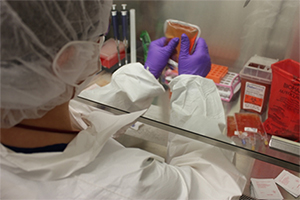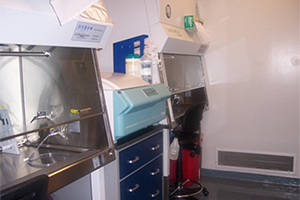Opexa Therapeutics, Inc. (Opexa) operates in a stand-alone facility located on one acre of forested land in the Woodlands, Texas. The company is comprised of over 10,000 sq. ft. of state of the art space for cGMP Manufacturing Suites, Quality Control Laboratory, Research and Development Laboratory, Quality Assurance, Clinical and Regulatory Affairs, as well as warehouse space for materials management.
Materials Management Warehouse
Provides warehouse space for the receipt and storage of materials for all of the laboratories. All oncoming raw materials, reagents, and consumables are initially received in the quarantine area of the warehouse until full receipt processing occurs which includes review of certificate of analysis/compliance for acceptability of material. Once approved for release, items are placed into active inventory. Materials are requisitioned for release for use in manufacturing and/or quality control based on projected workload. The requested items are then transferred from the warehouse to appropriate storage within the restricted access space.
Restricted Access and Quality Control Laboratories
Entrance into the restricted access laboratory area is through a primary gowning area where all personnel working inside the restricted access area are required to don street clothes and shoes in favor of laundered dedicated scrubs and dedicated work shoes. The restricted laboratory space is comprised of the Centralized accessioning, Quality Control laboratory, Quality Assurance workstation, internal storage for released consumables and manufacturing materials, and CGMP manufacturing suites.
Manufacturing Suite
 The 1100 sq. ft. GMP manufacturing area has capacity to manufacture cellular therapy material for clinical trials and renders services under the FDA (Food and Drug Administration) guidelines for cGMP and cGTP. Unescorted card controlled access to the manufacturing area is granted upon documentation of adequate training for working in a cleanroom environment. The space is configured with a secondary gowning area where the manufacturing staff don shoe covers, hair covering, and coveralls is added prior to entrance into the common corridor. The common corridor contains refrigerators and freezers for the storage of reagents that are labeled for patient specific use only. There are three tissue culture suites each containing biological safety cabinets which provide Class 100 environments for direct manipulation of clinical material, a centrifuge, and incubators. The design allows for easy adaptation to a wide variety of manufacturing processes. Room pressurizations, air flow, and flow of personnel, reagents and consumables, and clinical material provide Opexa Therapeutics with an integrated GMP-compliant operation. The facility has a central vacuum system distributed to all laboratory areas, and centralized CO2 and LN2 supply for distribution to appropriate locations. All critical equipment in the facility is connected to emergency power which is supported with a 250KW 60Hz - 285 gallon diesel generator with an automatic transfer switch and is monitored electronically.
The 1100 sq. ft. GMP manufacturing area has capacity to manufacture cellular therapy material for clinical trials and renders services under the FDA (Food and Drug Administration) guidelines for cGMP and cGTP. Unescorted card controlled access to the manufacturing area is granted upon documentation of adequate training for working in a cleanroom environment. The space is configured with a secondary gowning area where the manufacturing staff don shoe covers, hair covering, and coveralls is added prior to entrance into the common corridor. The common corridor contains refrigerators and freezers for the storage of reagents that are labeled for patient specific use only. There are three tissue culture suites each containing biological safety cabinets which provide Class 100 environments for direct manipulation of clinical material, a centrifuge, and incubators. The design allows for easy adaptation to a wide variety of manufacturing processes. Room pressurizations, air flow, and flow of personnel, reagents and consumables, and clinical material provide Opexa Therapeutics with an integrated GMP-compliant operation. The facility has a central vacuum system distributed to all laboratory areas, and centralized CO2 and LN2 supply for distribution to appropriate locations. All critical equipment in the facility is connected to emergency power which is supported with a 250KW 60Hz - 285 gallon diesel generator with an automatic transfer switch and is monitored electronically.
Quality Management Systems (QMS)
The Quality Management System consists of Quality Assurance, Quality Control, and Facility Management. Quality Assurance (QA) is responsible for establishing and maintaining a quality program that assures the overall quality and integrity of the manufactured product and maintains cGTP/cGTP compliance. The quality program is a responsible, authoritative element of Opexa that oversees the document management system, change control, occurrence management, materials management, facility integrity, product and process control, information management, records review, and product release. The occurrence management system encompasses non-conformance documentation, OOS, CAPA, and provides a mechanism for orderly continual improvement. Periodic audits serve to monitor for compliance.
Quality control (QC) utilizes a centralized accessioning process for specimen management which provides traceability and ensures specimen integrity throughout manufacturing and testing processes. Analytical and bioassays for product release testing of clinical material are performed in QC. QC also conducts the environmental monitoring of the GMP laboratory and performs all reagents specific release testing. QC maintains the inventory of in-house formulated reagents and controls the release of these reagents to manufacturing, QC, and R & D laboratories.
Facility management (FM) oversees material management, supply chain distribution, facility maintenance and improvements, general housekeeping, cleaning of QC labs and the clean rooms, equipment management, and service contracts. FM works with all departments to qualify all instrumentation. In conjunction with QC, FM monitors the microbial trends within the cleanroom suites.
Clinical and Regulatory Affairs (CA, RA)
An integral part of the team, CA/RA ensures compliance with FDA and other regulatory requirements in all stages of clinical development. The staff prepares, manages, and maintains regulatory submissions including clinical trial related documents, facilitating submissions to the FDA, IRB, and other regulatory entities. They also provide insight into protocol design which results in studies that meet regulatory and scientific requirements, but are achievable within the desired timelines. The staff supports clinical investigators through all stages of the clinical trial process; review and track site regulatory and clinical trial documentation; and manages the CRO (Contract Research Organization) to assure the collection, evaluation, and reporting of safety information, including serious adverse events and other significant safety events.
Research and Development (R&D)
 The 1200 sq. ft. R&D Laboratory provides space for evaluation of potential new technology, on-going process development of existing technologies, and includes an area for scale-up of processes prior to introduction into the GMP facility. The space and equipment supports the tissue culture, molecular, and bioassay activity necessary to fully develop and implement new techniques or processes that expand our core technologies.
The 1200 sq. ft. R&D Laboratory provides space for evaluation of potential new technology, on-going process development of existing technologies, and includes an area for scale-up of processes prior to introduction into the GMP facility. The space and equipment supports the tissue culture, molecular, and bioassay activity necessary to fully develop and implement new techniques or processes that expand our core technologies.
Scientist and technical staff in R&D formulate and analyze pre-clinical models, and work in conjunction with manufacturing to optimize the conditions and techniques for making the clinical protocol a reality. They address issues involved in the scale up techniques and processes to meet the volumes associated with clinical trials, developing closed systems for the techniques, and then translate this knowledge to the manufacturing staff. The R&D staff also develops and executes assays for accessing the immunological efficacy of clinical trials.